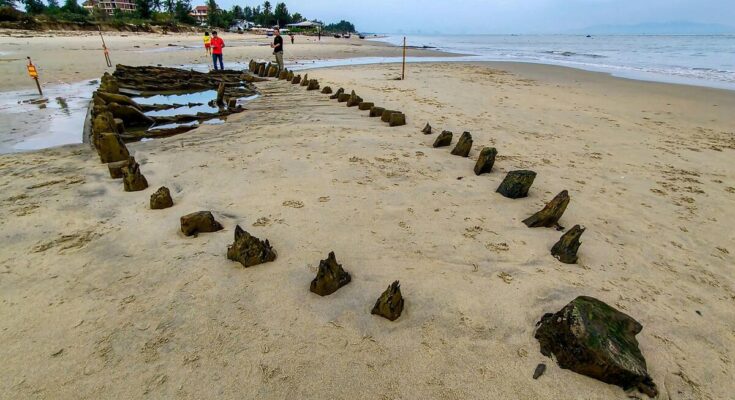Experts will be able to examine the wreck stuck in the sand at the end of 2023, before the sea swallows it again.
Massive coastal erosion that reveals a piece of sea sinking history. Typhoon Kalmaegi was devastating: it killed at least five people in Vietnam, after leaving the Philippines in mourning, with 224 deaths according to the latest report. A powerful storm uncovered centuries-old shipwrecks in Vietnam, offering a chance to rediscover major historical finds, experts say.
“We are currently preparing to apply for an emergency excavation permit,” Pham Phu Ngoc, director of the Hoi An World Cultural Heritage Preservation Center, told AFP on Monday.
Rafters, partitions, beams… On Monday, the wreck was still clearly visible and many people gathered on the beach to admire its impressive structure.
Found in 2023
Originally discovered in late 2023 off the coast of Hoi An, near the Cham Islands, this ship, at least 17.4 m long and 5 m wide, whose almost intact wooden hull survived hundreds of years of rough seas, sank again before authorities could recover it.
Permission has been sought from several local authorities to search the wreckage. But before it can be removed from the water, under optimal preservation conditions, it is taken over by the sea. But a team of experts from the Hoi An preservation center, Ho Chi Minh City University and local museums managed to examine it.
Early experts found that the boat was made of “durable and very strong woods”, lagerstroemia, kien kien and Chinese pine, and reinforced with waterproof material to seal the joints. “The structure of the ship shows that it is capable of traveling long distances (…),” the Hoi An center said in an earlier press release.
Built between the 14th and 16th centuries
Although it cannot be dated to carbon 14, the first element indicates that the ship was built between the 14th and 16th centuries, at a time when Hoi An was a thriving regional trade center.
The old town retains its traditional wooden architecture, yin and yang tiled roofs, facades, as well as the size of the built land and its circulation plan, between the Hoài River and the coastline, which earned it UNESCO world heritage status. It has become a major tourist location, which the authorities, with the help of UNESCO, are working to preserve.
The wreck risks “seriously deteriorating if conservation measures are not taken immediately”, given the intense coastal erosion and the ship’s frequent exposure to adverse weather conditions, according to the same source.



